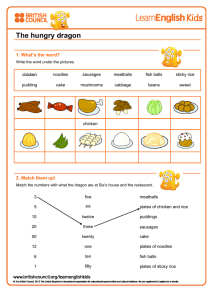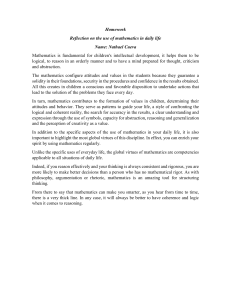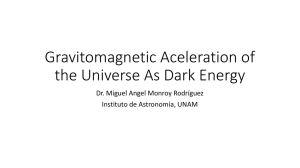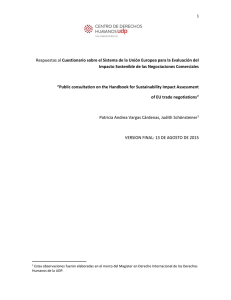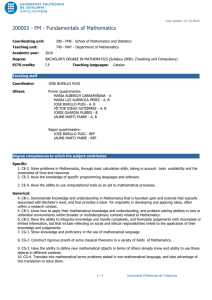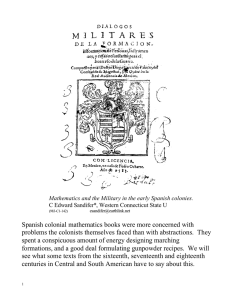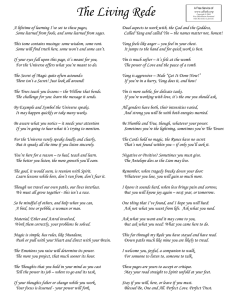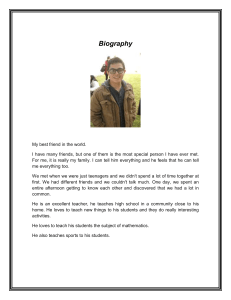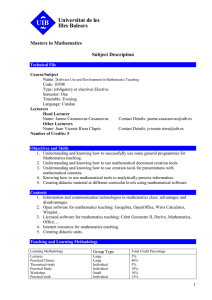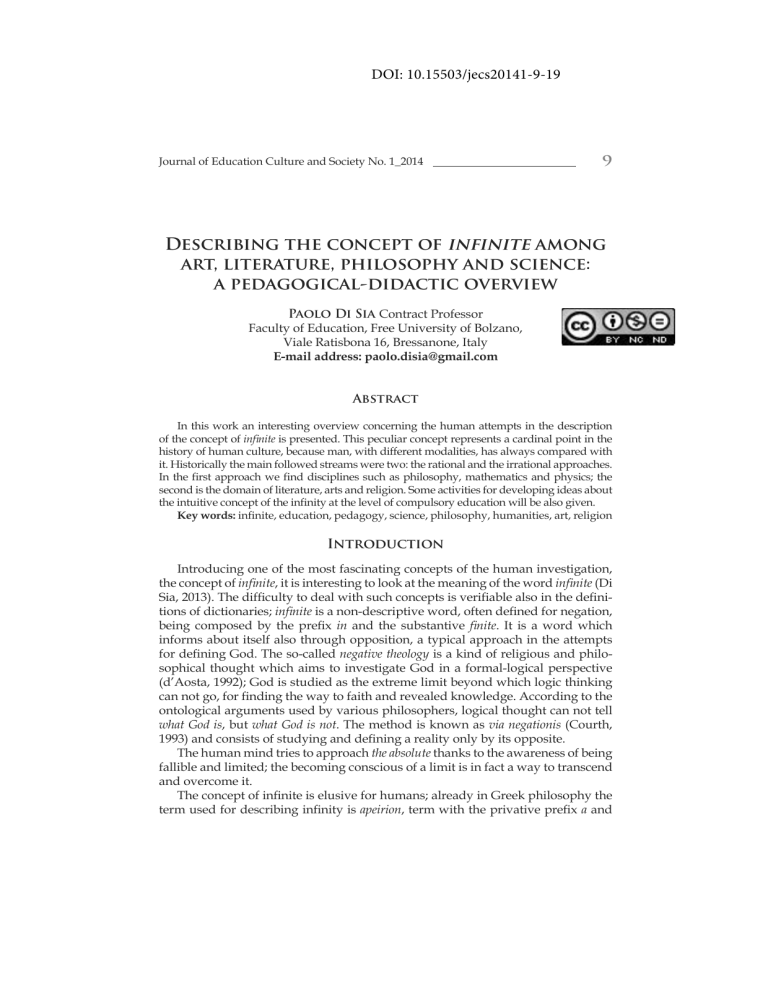
DOI: 10.15503/jecs20141-9-19 Journal of Education Culture and Society No. 1_2014 9 Describing the concept of infinite among art, literature, philosophy and science: a pedagogical-didactic overview Paolo Di Sia Contract Professor Faculty of Education, Free University of Bolzano, Viale Ratisbona 16, Bressanone, Italy E-mail address: [email protected] Abstract In this work an interesting overview concerning the human attempts in the description of the concept of inÞnite is presented. This peculiar concept represents a cardinal point in the history of human culture, because man, with different modalities, has always compared with it. Historically the main followed streams were two: the rational and the irrational approaches. In the Þrst approach we Þnd disciplines such as philosophy, mathematics and physics; the second is the domain of literature, arts and religion. Some activities for developing ideas about the intuitive concept of the inÞnity at the level of compulsory education will be also given. Key words: inÞnite, education, pedagogy, science, philosophy, humanities, art, religion Introduction Introducing one of the most fascinating concepts of the human investigation, the concept of inÞnite, it is interesting to look at the meaning of the word inÞnite (Di Sia, 2013). The difÞculty to deal with such concepts is veriÞable also in the deÞnitions of dictionaries; inÞnite is a non-descriptive word, often deÞned for negation, being composed by the preÞx in and the substantive Þnite. It is a word which informs about itself also through opposition, a typical approach in the attempts for deÞning God. The so-called negative theology is a kind of religious and philosophical thought which aims to investigate God in a formal-logical perspective (d’Aosta, 1992); God is studied as the extreme limit beyond which logic thinking can not go, for Þnding the way to faith and revealed knowledge. According to the ontological arguments used by various philosophers, logical thought can not tell what God is, but what God is not. The method is known as via negationis (Courth, 1993) and consists of studying and deÞning a reality only by its opposite. The human mind tries to approach the absolute thanks to the awareness of being fallible and limited; the becoming conscious of a limit is in fact a way to transcend and overcome it. The concept of inÞnite is elusive for humans; already in Greek philosophy the term used for describing inÞnity is apeirion, term with the privative preÞx a and 10 Ethics substantive peirar, which means limit, border. In the millennial effort for understanding the concept, there are two basic approaches followed by humans: the rational and the irrational approaches. Rational approaches to the concept of infinite In the history of philosophical thought, the concept of inÞnite had different interpretations and developments. However, it is posible to recognise three main concepts: the negative Greek philosophy, the positive Christian thought and the concept of modern thought, especially of mathematical thinking. The concept of inÞnite in Greek thought. In the Greek language, the term used for describing inÞnity is apeiron, etymologically dating back to the two terms a (not) and peras (limit). In the form peiras of the Ionic dialect of Miletus, it represents, according to the philosophy of Anaximander, the origin and the constituent principle of the universe (Colli, 1978; Anaximander, 1991, & Mueller, 1848). It is an inÞnite, unlimited, eternal, indestructible and constantly mobile matter, the Þrst principle of all things. With Pythagoreans, a real speculation about the inÞnite is reached, through the association of it with the imperfection, the absence of form. This interpretation is the foundation of the concept of horror inÞniti and is visible in the paradoxes of Zenone of Elea. The prevailing conception of inÞnite in the Greek world, however, is that of Aristotle, in which inÞnity is identiÞed with the pure negativity of the potential matter. Epicureans, referring to the conception of Democritus, understood inÞnity in a positive sense, identifying it with the vacuum and as essential component of the universe in the original condition (Geymonat, 1970; Canfora, 2004). The concept of inÞnite in Christian thought. Through the mediation of NeoPlatonism, Christian thought processed a positive conception of the inÞnity, based on the notion of God as the creator of Þnite realities. St. Anselm explicitly identiÞed the divine essence with the inÞnite, both because this essence has no limits, and because it has an inÞnitely creative force. In the identity God-InÞnity is also contained the transcendent nature of the divine, a basic concept proposed by Nicholas Cusano at the beginning of Humanism, in which there is an identiÞcation of the concept of mathematical inÞnite with the real inÞnity of God (Nagasawa, 2011; Wierenga, 1989). The concept of inÞnite in Modern Thought. Starting from the ideas of Cusano, Giordano Bruno elaborated the modern version of the concept of inÞnite. In this version, the inÞnite becomes the very foundation of the universe, since the world has penetrated into every point by the creative activity of God (Di Sia, 2006; Bruno, 1998). Giordano Bruno tends to unify the actual, not only potential, way the Þnite with the inÞnite, building the starting point for the subsequent metaphysical elaborations of the pure Ego of Fichte, the Absolute of Schelling and the Spirit of Hegel (Weber, 2009; Falckenberg, 2013), with which the total speculative identiÞcation of a particular Þnite situation with the inÞnite is reached. The inÞnite in mathematics. Near the speculative philosophical tradition, there is a concept of the inÞnite of a logical-mathematical kind, related to thinkers of the Journal of Education Culture and Society No. 1_2014 11 level of Descartes, Newton and Leibniz. It is a positive vision of inÞnite by considering it in a more instrumental than ontological modality; this has produced the theory of the inÞnitessimal calculus and the theory of limits (Di Sia, 2013; Di Sia, 2014). Subsequently, the concept of the inÞnite has been developed in more specialized areas, such as mathematics and formal logic, through the contributions of Gauss and Weierstrass. In modern mathematics there are different interpretations of the concept of inÞnite, properly addressed to a particular domain. In general, the main interpretations are related to set theory, analysis and geometry. The inÞnite in set theory. Starting from the intuitive concept of a Þnite set, i.e. a collection in which it is possible to enumerate in Þnite time the elements, it is posible to deÞne an inÞnite set as a not equivalent set to a Þnite set, i.e. with the impossibility to put it in bijective correspondence with the Þnite set (Conner, 2011). It exists also as a direct deÞnition of an inÞnite set, as a set that can be put in bijective correspondence with one subset of it. (for example, the set of integers and that of even numbers). At the end of the nineteenth century, several mathematicians contributed to the extension of the concept of ordinal and cardinal numbers to inÞnite sets, arriving at the deÞnition of transÞnite numbers. The notion of a transÞnite number extends the notion of number; the arithmetic operations and the order relation of natural numbers are extended to a broader class of objects with respect to the usual numbers. These entities have been introduced by Georg Cantor and serve to provide an important tool in set theory and in general in mathematics (Cantor, 2012). With these types of numbers it has been possible to categorize different types of inÞnite and thus to build a real arithmetic of the inÞnite, which turned out to be fundamental in the subsequent development of mathematics. Today the transÞnite numbers are a fundamental chapter in the mathematical culture and are accepted and used, although in some cases have generated logical paradoxes of difÞcult solution (Dauben, 1990). The inÞnite in analysis. The systematic introduction of the inÞnite in mathematical analysis is due to Augustin-Louis Cauchy, who deÞned, at the same time, also the concept of inÞnitessimal; it is tightly connected to the concept of limit. A real number l is the limit of f(x), for x approaching to x0, if the distance between f(x) and l is arbitrarily small when x approaches x0. The distance among the points is measured using the absolute value of the difference between x and x0, i.e. x x0 , and f ( x) l is the distance between f(x) and l. The concept of arbitrarily small is formally expressed through the quantiÞers for all ( ), universal quantiÞer, and it exists ( ), existential quantiÞer. The same procedure applies when f(x) tends to positive or negative inÞnite, f ( x) r f . In this meaning, it does not give a deÞnition of inÞnite writing xlim o x0 as a number, but as a limit, i.e. the inÞnite is deÞned by means of its surroundings. The inÞnite in geometry. The concept of inÞnite is located in the building of special geometrical situations used as a foundation. For example: 1. the point at inÞnity of a straight line is its direction, i.e. the class of parallel straight lines to the Þrst line; 2. the plane at inÞnity of the space is the set of points and straight lines to inÞnite; 12 Ethics 3. straight lines with the same point at inÞnity are parallel straight lines; 4. planes with the same line at inÞnity are parallel planes. These concepts allow an elegant formulation of situations of parallelism between lines and planes. InÞnite and inÞnitessimal in physics. Contemporary physics is closely related both to the concept of inÞnite and of inÞnitessimal. By its nature, physics deals with problems on extreme dimensional scales; the physics of matter studies very small sizes, while astronomical/cosmological physics deals with huge quantities. The amazing thing is the congruence of adopted theoretical models: 1. the modern atomic model is tightly connected to the morphology of the celestial bodies; 2. the atom-electron structure remembers that of planet-satellite; 3. among the two structures there are innumerable orders of magnitude. The exploration of the atom, initially held as indivisible, as the same name testiÞes, led to the discovery of smaller particles, but still divisible. Imagining repetition of the process of division so many times, the concept of physical inÞnitessimal can be realized; it is possible to think it as the minimum unity of matter on which the whole universe is built. Vice versa, the exploration of cosmos led to the widening of conÞnements of known space and to a consequent mutation in the general cosmological conception (Di Sia, 2000). It is precisely in the different cosmological models that the concept of inÞnite enters with full force. The two most important studied models are: 1. the static model; 2. the inßationary model. In the Þrst one, the universe is understood as an entity without beginning, or end. The universe has always been as it is today; it is therefore not determined by events such as birth. In such a context there is a sort of identity between spatial inÞnite and temporal inÞnite (eternity). In the inßationary model the universe originated from a disruptive event called the Big-Bang and this event is followed by an expansion process, still in progress. There are also two variants of the inßationary model: 1. the expansion of the universe is seen as a never-ending process, without return, an irreversible process; 2. the expansion will continue until a critical point, after which a phase of compression of the material will begin, culminating in a new big bang. The second kind of expansion is called also the pulsating universe; it shares with the static model the key concept that the life of the universe is eternal and the universe extends itself in space to inÞnity. In the static model this happens for datum of fact, while in the pulsating model it happens through cycles of compression-expansion, eternally repeating. Therefore the inÞnite, under various forms, is inside the reality to all levels and to all scales; by the inÞnitely great (real inÞnity) to the inÞnitely small (inÞnitessimal) (Di Sia, 2001; Albeverio & Blanchard, 2013). Journal of Education Culture and Society No. 1_2014 13 Not rigorously rational approaches to the concept of infinite In the products of art, the concept of inÞnity Þnds great expression; a lot of artists have confronted the reality of it. In this paper we examine in particular the areas of poetry, literature and graphic arts. The inÞnite in poetry. The comparison with the inÞnite in the poetry Þnds a milestone in one of the greatest Italian poets, Giacomo Leopardi, who wrote a poem just titled The InÞnite. Leopardi attempts a description of the inÞnite through a connection, putting the inÞnite in relation to what is known, Þnite; the description of the inÞnite results from opposition. The inÞnite is described as that, which is beyond the hedge, going beyond our physicality: “Sempre caro mi fu quest’ermo colle, e questa siepe, che da tanta parte dell’ultimo orizzonte il guardo esclude” (Leopardi, 2013) “Always dear it was to me this lonely hill, and this hedge, that from so many parts of the last horizon excludes the view”. The last horizon represents the true limit of the human nature with respect to the universe. It is the last, in the sense of not surmountable, not crossable, therefore not entirely understandable. With this comparison the poet gains a partial attainment of the inÞnite and reaches a new dimension: “e mi sovvien l’eterno, e le morte stagioni, e la presente e viva, e il suon di lei” (Leopardi, 2013) “and the eternity helps me, and the death seasons, and the present and live one, and its sound”. Opposite however is the interpretation given by the poetry of Giovanni Pascoli in the poem The vertigo. In his vision, the perspective is no longer geocentric, there is no comparison with the Þnite, but there is the suggestion proposed by the inÞnite spaces, by the astronomical dimensions: “Qual freddo orrore pendere su quelle lontane, fredde, bianche azzurre e rosse, su quell’immenso baratro di stelle, sopra quei gruppi, sopra quelli ammassi, quel seminìo, quel polverìo di stelle!” (Pascoli, 2012). “What cold horror to hang on those distant, cold, whites, blues and reds, on those immense abysses of stars, above those groups, above those heaps, seeding, powder of stars!”. The entire second part of the poem is based on a cosmological vision of the inÞnite and the poet is completely dominated and lost; not surprisingly, he describes the inÞnite with the expression cold horror. The two poems, however, have a common feature: in both poets there is the perception of a pleasure given by collapsing into the unknown. Leopardi says: “Così tra questa immensità s’annega il pensier mio: e il naufragar m’è dolce in questo mare” (Leopardi, 2013) “So in this immensity my thought is drowned: and the shipwreck is sweet in this sea”. 14 Ethics Similarly Pascoli, on the end of the work, writes: “precipitare languido, sgomento, nullo, senza più peso e senza senso. Sprofondar d’un millennio ogni momento!” (Pascoli, 2012). “to precipitate languid, dismay, nothingness, without weight and meaningless. To collapse of a millennium at any instant!”. For the Þrst poet there is a sweet shipwreck in the sea of the unknown, for the second a languid fall in the cosmic space. We have therefore two very different visions: the man, though frightened by the unknown, seeks to compare himself with it, enjoys thinking of the inÞnite. The inÞnite in literature. Even in literary works in prose the inÞnite was considered. In various forms, several writers compared with this concept and produced different and imaginative interpretations. The English writer Laurence Sterne, in his masterpiece The Life and Opinions of Tristram Shandy, Gentleman, or brießy Tristram Shandy, (Sterne, 1992) describes the inÞnite in a very similar way to Zenone’s paradox of Achille and the turtle. He takes one year to describe a single day in his own life, leaving so irremediably late. Therefore the work is impossible to Þnish, it is a kind of inÞnite regression that will never allow completion. Different is the reading given by the Argentine writer Jorge Luis Borges in the short story The Library of Babel (Borges, 1944); he talks about the existence of a book in a library, in which all books are listed, a kind of large index of the library, itself written in a book. The paradox is obvious: for completing the indexing of volumes, it would be necessary to launch a new book, listing the Þrst index and then again ad inÞnitum. One of the most special literary interpretations is present in the work of the Irish writer James Joyce. His whole work, represented emblematically by Ulysses (Joyce, 2013), is the description of the inÞnite tortuous movements of the human mind. Ulysses is an ordinary person and his wandering is not geographical, as in the Homeric version, but mental. The book describes the inÞnite stream of thoughts, the stream of consciousness of the protagonist, creating a very intricate labyrinth in which the reader is thrown. Graphical representations of the inÞnite. The inÞnite has been described in various ways in the graphic arts. One of the most interesting visions is that proposed by the Dutch engraver Mauritius Cornelius Escher. He looked at the inÞnite in two different ways: 1. the inÞnite divisions of the plane; 2. the inÞnite movements of the space. In the Þrst way we Þnd works as in Þgure 1 (Taylor, 2009). Escher creates a special geometry in Figure 1. Circle limit IV (M. C. Escher) which the visual plane is divided into Source: http://www.mcescher.com/. Journal of Education Culture and Society No. 1_2014 15 smaller and smaller sections, always equal to themselves. In Þgure 1 the fragmentation occurs to the outer edge, but in works as Smaller and Smaller (Þgure 2) this happens in reverse, towards the centre. To the second set belong works such as “Ascending and Descending” (Þgure 3). In this famous lithography, Escher intends to represent a physical paradox in which, through an optical effect, the men represented in the upper part go up (or down) indeÞnitely. Still inÞnite motion is represented, although in another sense, in works as Moebius Strip II (Þgure 4). There is no solution of continuity between the internal and external dimensions of the Þgure; it is not posible to distinguish between an inside and an outside. Figure 2. Smaller and Smaller (M. C. Escher) Source: http://www.mcescher.com/. Figure 4. Moebius Strip II (M. C. Escher) Source: http://www.mcescher.com/. Figure 3. Ascending and Descending (M. C. Escher) Source: http://www.utwente.nl/ewi/trese/. Figure 5. A fractal Source: http://www.math.harvard.edu/. 16 Ethics Also particular mathematical constructions can generate interesting Þgures, in which the concept of inÞnite is implicit. In fractals, particular Þgures introduced by the mathematician Benoît Mandelbrot, we Þnd a division of the plan, which is very similar to that imagined by Escher (Þgure 5). A fractal is a geometric object, which is endowed of internal homothety, i.e. repeats itself in its form on different scales. The term fractal was coined by Mandelbrot in 1975 (Di Sia, 2013; Di Sia, 2014; Mandelbrot, 1982; Mandelbrot, 2004, & Pickover, 2001), for describing some mathematical behaviour that seemed to be chaotic. It derives from the Latin fractus, broken, as well as the mathematical term fraction. Nature produces many examples of forms, which are very similar to fractals; for example, in trees, especially in Þrs, each branch is approximately similar to the whole tree, each small part of branch is similar to its own branch, and so on. Fractals are also present in the geomorphology of mountains, in clouds, in ice crystals, in some leaves and ßowers. The fractal art is created by calculating fractal mathematical functions and transforming the results of calculations into pictures, animations, music and other forms of artistic expression. The religious tension toward the inÞnite. Sometimes the advanced theoretical models of science reßect ancient beliefs of man and religion; often the relationships between science and religion have been not conßictual, but complementary. For example, in the cosmological vision of the inßationary model, the universe is not eternal. The universe is born through a catastrophic event, develops and, with all probability, dies. Such conception is near to the cosmological model proposed by the Christianity. The beginning of the holy Bible, Genesis, states: “At the beginning God created the sky and the earth” (Gn 11). The end of the Bible, Apocalypse, states that the world will end with the “Universal Judgment”, at the end of times (Ap 1616) (The Holy Bible, 1993). So, for the Christian religion, space and time are Þnite, as for the inßationary model. Other religions intend instead the time as inÞnite and therefore are near to the static model. In Hinduism, the three Gods Brahma, Vishnu and Shiva create, hold in life and destroy cyclically the universe, a very similar conception to the pulsating model (Flood, 1996; Zimmer, 1972). In conclusion, the monotheist religions (Judaism, Christianity, Islam) intend the universe as Þnite and as product of a creative event of God; in the polytheist religions, instead, the universe is understood as eternal and it is not directly connected to the generative intervention of a divinity. The infinite at the level of compulsory education The intuitive knowledge of students, acquired in extra-scholastic contexts or in previous studies, can facilitate or obstruct in a decisive way the learning of a concept. Fischbein refers to such intuitive ideas as to primary intuitions and underlines the opportunity to strengthen them; so they can evolve as secondary intuitions, constituting a propitious ground for the acquisition of the concepts (Fischbein, 1973; Fischbein, 1987). These results are particularly important in the case of the most complex and delicate concepts of mathematics, as the concept of inÞnite and those Journal of Education Culture and Society No. 1_2014 17 tightly connected of inÞnitessimal, limit and continuity (Di Sia, 2013; Di Sia, 2014). About the difÞculties connected with such concepts, the presence of real epistemological obstacles has been underlined (Di Sia, 2013; Di Sia, 2014; Brousseau, 1983; Sierpinska, 1985, & Sierpinska, 1987), suggesting the opportunity of particular didactic choices (Grugnetti-Rizza et al., 1998; Hauchart & Schneider, 1996). DifÞculties of linguistic nature are also present, due to the veriÞable ambiguities of the daily use of terms as limit and inÞnite (Grugnetti-Rizza et al., 1998; Alberti-Andriani et al., 2001). With the purpose of exploring the intuitive knowledge of students of primary and secondary school, related to the concepts of inÞnite and inÞnitessimal, research showed the presence of primary intuitions at all considered age levels. On the other hand, if not adequately considered, these insights generally tend to regress in the course of the school years. The teaching practice seems to have mainly the effect of moving the attention more on calculation than on reasoning (Di Sia, 2013; Di Sia, 2014, & Andriani et al., 1998). The basis mathematics is very rich in possibilities for gradually familiarizing with the concept of inÞnite; the mandatory school can have a fundamental inßuence in the development of favorable mental images of inÞnite. As example, we remember the question of the division by zero; it is often quickly resolved as not motivated prohibition, which risks to produce distorsions and errors. It could become on the contrary an opportunity for speaking of numbers growing over every Þxed limit and for arousing questions and curiosity about the inÞnite (Þgure 6). Figure 6. Thinking about the concept of inÞnite and inÞnitessimal. Source: personal elaboration. In textbooks, a confrontational attitude is often present; some authors carefully avoid terms such as inÞnite, limit, continuous, others use expressions such as to be satisÞed of such approximation for…, to go close to…. In this way, the deep sense of the problem is lost, so as the possibility of a right comprehension of the approximation. A matter constituting one of the Þrst occasions for approaching the concept of inÞnite and the idea of limit, are the geometric progressions; students meet them already in the mandatory school. The convergence and divergence, in relation to the value of the reason of the progression, represents an interesting window on the problem of inÞnite. Particular interest have sums of numbers in geometric progression, as for example: S1 = 1 + 1/2 + 1/4 + 1/8 + ……. (convergent sum), or: S2 = 1 + 2 + 4 + 8 + ……. (divergent sum). 18 Ethics It is possible, starting in the mandatory school, to realize cards in which the request is to imagine the Þnal behaviour of a particular sequence of geometric Þgures. The purpose of cards is also the understanding of the idea of iteration, so as the difference between convergent and divergent processes (Þgure 7). Figure 7. Convergent and divergent processes Source: personal elaboration. Conclusions The concept of inÞnite is intimately connected to the development of humanity, in all intellectual, artistic, scientiÞc expressions. Such a concept is therefore a limit, a border of the human generation, intrinsically opposite to that of inÞnite. Through this comparison, humanity better understands its own state, delineates its own nature. With investigation on the inÞnite, humanity has understood during the course of history a lot of dynamics and resolved many problems. There exists a metaphor, in which knowledge is compared to an island and ignorance to the border of the island with the sea, i.e. with the unknown. Increasing knowledge, i.e. the island, ignorance also increases; but for geometric reasons, ignorance grows in linear way, while knowledge grows in a quadratic way, being an area. The knowledge of inÞnite has certainly created problems, but at the same time has increased and currently increases the knowledge of humanity, making possible such new knowledge for physics, mathematics and in general for the pure thought. Complex concepts, as that of inÞnite, can be deeply understood only as an immense task. Beginning from the most spontaneous and immediate intuitions, it can create in every child, which will become an adult, a coherent and solid picture of mental images. The exploration of the inÞnite leads also students to reason in terms of approximation, accuracy and control of mistakes (Di Sia, 2013; Di Sia, 2014). References Alberti, N., Andriani, M. F., Bedulli, M., Dallanoce, S., Falcade, R., Foglia, S., Gregori, S., Grugnetti, L., Marchini, C., Molinari, F., Pezzi, F., & Rizza, A. (2001). On the difÞculties of learning the concept of limit. Parma: Riv. Mat. Univ. Parma, 6(3), 1-21. Albeverio, S., & Blanchard, P. (Eds). (2013). Direction of Time. New York: Springer. Anassimandro of Mileto (1991). Fragments and testimonies. Paris: Presses universitaires de France. Andriani, M. F., Dallanoce, S., Grugnetti, L., Molinari, F., & Rizza, A. (1999). Autour du concept de limite. In: F. Jaquet (Ed.), Proceedings of CIEAEM 50, Neuchâtel 2-7 August 1998, 329-335. Borges, J. L. (1944). Ficciones (1935-1944). Buenos Aires: SUR. Journal of Education Culture and Society No. 1_2014 19 Brousseau, G. (1983). Epistemological obstacles and problems in mathematics. Research in Mathematics Education, 4 (2), 165-198. Bruno, G. (1998). Cause, Principle and Unity: And Essays on Magic. Series in Cambridge Texts in the History of Philosophy. Cambridge: University Press. Canfora, L. (2004). We and the ancients. Why to study Greeks and Romans is useful for the intelligence of modern. Rizzoli, Milano: BUR Biblioteca University. Cantor, G. (1955). Contributions to the Founding of the Theory of TransÞnite Numbers. New York: Dover. Colli, G. (1978). Greek wisdom II - Epimenide, Ferecide, Talete, Nico, Dario, Ennio, Anassimandro, Anassimene, Onomacrito. Milano: Adelphi. Conner, J. (2011). On the Logical Form of Correlatively InÞnite Sets, Bloomington: Xlibris Corp. Courth, F. (1993). The mystery of God Trinity. Milano: Editoriale Jaca Book. D’Aosta, A. (1992). Proslogion. Milano: BUR Biblioteca University. Dallanoce, S., Grugnetti, L., Molinari, F., Rizza, A., Andriani, M. F., Foglia, S., Gregori, S., Marchini, & C., Pezzi, F. (2000). A cognitive co-operation across different sectors of education. In: Ahmed, A., Kraemer, J. M., and Williams, H. (Eds.). Proceedings of conference CIEAEM 51. Chichester: Horwood Publishing, 297-303. Dauben, J. W. (1990). Georg Cantor: His Mathematics and Philosophy of the InÞnite. Princeton: Princeton University Press. Di Sia, P. (2000). The role of space and time in the evolution of uniÞed theories (part 1). MatematicaMente, 25, 1. Di Sia, P. (2000). The role of space and time in the evolution of uniÞed theories (part 2). MatematicaMente, 27, 1-2. Di Sia, P. (2000). The role of space and time in the evolution of uniÞed theories (part 3). MatematicaMente, 28, 2. Di Sia, P. (2001). The Þrst second of the Universe. MatematicaMente, 40, 1-2. Di Sia, P. (2006). Time, man, God: Reßections (part 1). MatematicaMente, 99, 1-2. Di Sia, P. (2006). Time, man, God: Reßections (part 2). MatematicaMente, 100, 2. Di Sia, P. (2013). Elements of Mathematics Education I - Laboratory. Roma: Aracne Editrice. Di Sia, P. (2013). Foundations of Mathematics and Education I. Roma: Aracne Editrice. Di Sia, P. (2014). Foundations of Mathematics and Education II. Roma: Aracne Editrice. Falckenberg, R. (2013). History of Modern Philosophy: From Nicolas of Cusa to the Present Time. Seattle: CreateSpace Independent Publishing Platform. Fischbein, E. (1973). Intuition, structure and heuristic methods in teaching Mathematics. In: A. G. Howson (Ed.). Developments in Mathematical Education. Cambridge: Cambridge University Press, 222-232. Fischbein, E. (1987). Intuition in Science and Mathematics. Dordrecht: D. Reidel Publishing Company. Flood, G. (1996). An Introduction to Hinduism. Cambridge: Cambridge University Press. Geymonat, L. (1970). History of philosophical and scientiÞc thought. Milano: Garzanti. Grugnetti, L., Rizza, A. & al. (1999). The limit concept: what is the relationship with the natural language? In: F. Jaquet (Ed.). Proceedings of conference CIEAEM 50, Neuchâtel 2-7 August 1998, 313-318. Hauchart, C., Schneider, M. (1996). A heuristic approach to Analysis. Repères quarterly journal, Aix-Marseille: IREM University, 25, 35-60. Joyce, J. (2013). Ulisse. In: G. Celati (Ed.), Letture. Torino: Einaudi. Leopardi, G. (2013). Opere. Torino: UTET. Mandelbrot, B. B. (1982). The Fractal Geometry of Nature. Cranbury: W. H. Freeman and Company. Mandelbrot, B. B. (2004). Fractals and Chaos: The Mandelbrot Set and Beyond. New York: Springer. Mueller, C. (1848). Fragmenta Historicorum Graecorum. Paris: Parisiis. Nagasawa, Y. (2011). The Existence of God. London: Taylor & Francis. Pascoli, G. (2012). Various poems. London: Ulan Press. Pickover, C. A. (2001). Computers, Pattern, Chaos and Beauty. New York: Dover Publications. Sierpinska, A. (1985). Epistemological obstacles related to the notion of limit. Recherches en Didactique des Mathématiques, 6 (1), 5-67. Sierpinska, A. (1987). Humanities Students and Epistemological Obstacles Related to Limits. Educational studies in Mathematics, 18 (4), 371-397. Sterne, L. (1992). Life and Opinions of Tristram Shandy, Gentleman. Milano: Grandi Classici Mondadori. Taylor, R. (2009). Reßecting the impossible. Nature, 460, 462. The Holy Bible: New International Version (1993). Red Lion: HarperTorch. Weber, A. (2009). History of Philosophy. Charleston: BiblioBazaar. Wierenga, E. R. (1989). The Nature of God: An Inquiry Into Divine Attributes. Ithaca: Cornell University Press. Zimmer, H. (1972). Myths and Symbols in Indian Art and Civilization. Princeton: Princeton University Press.
